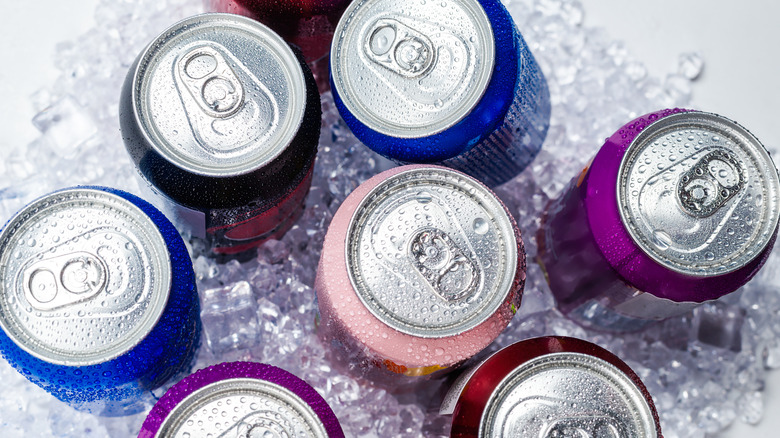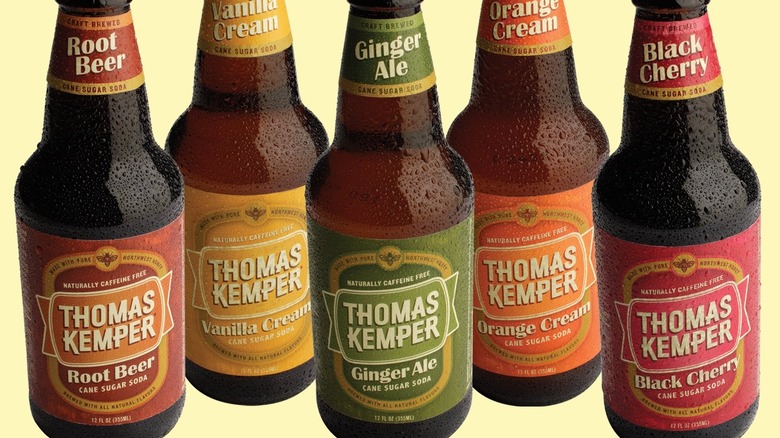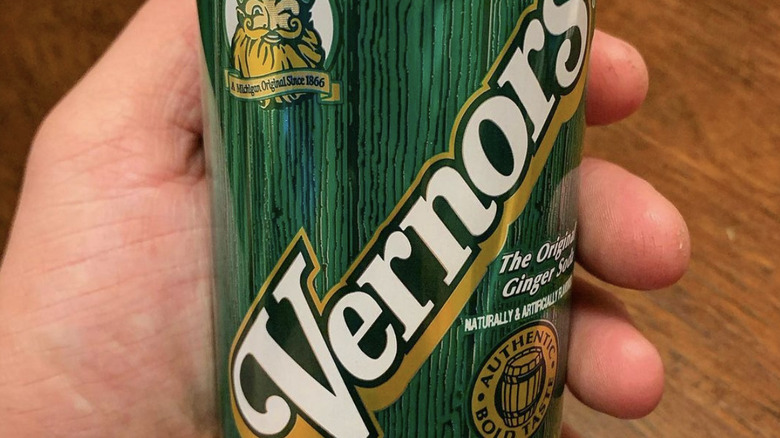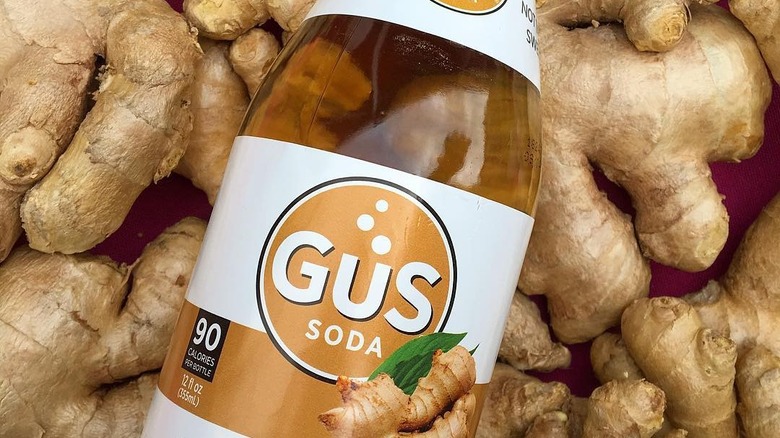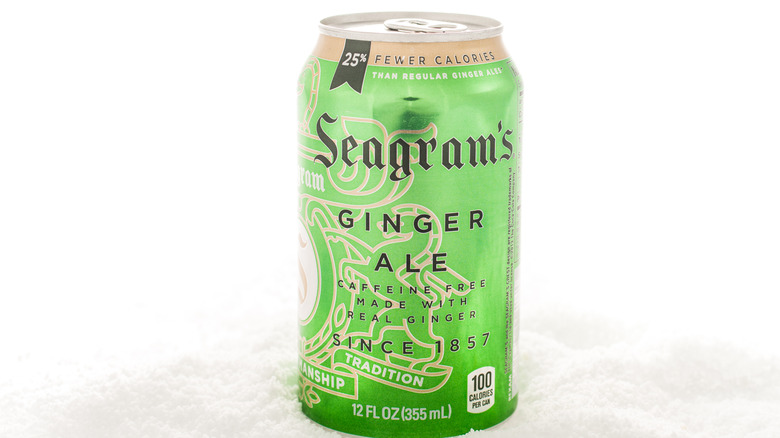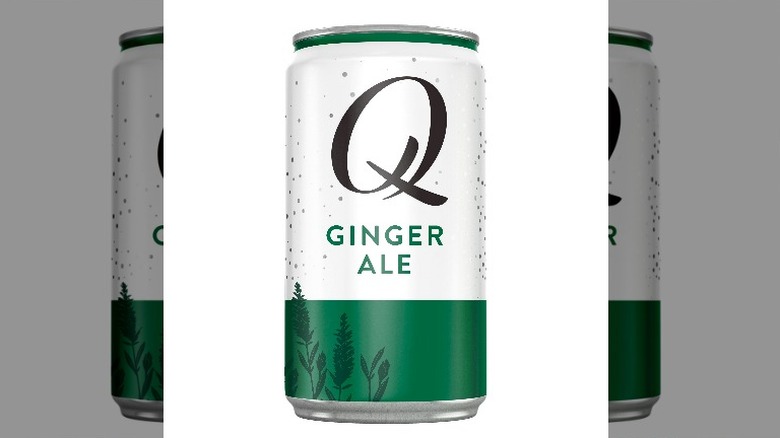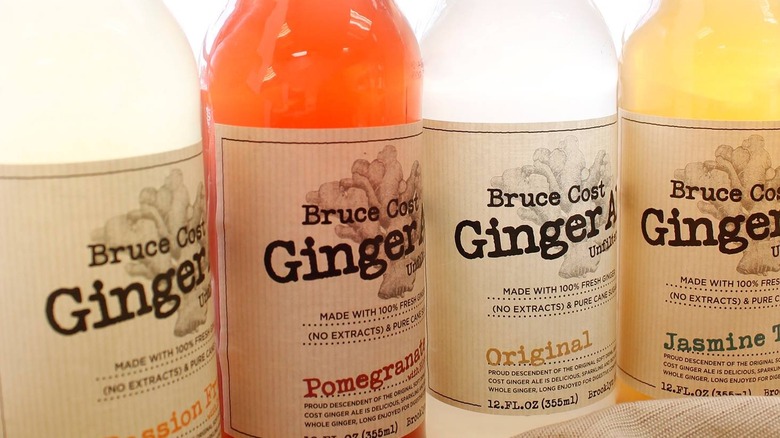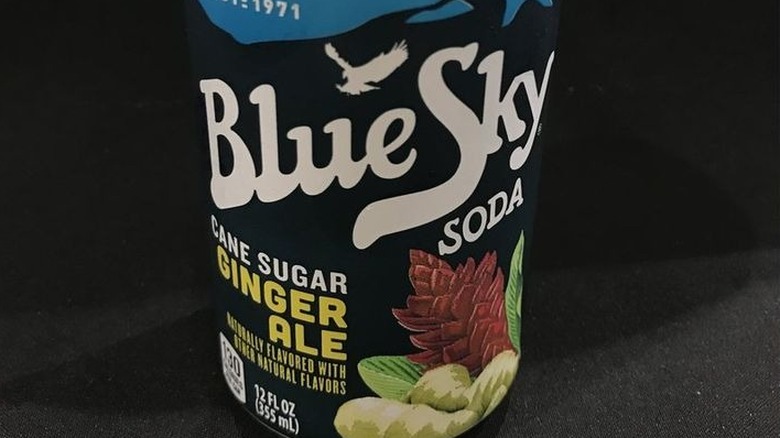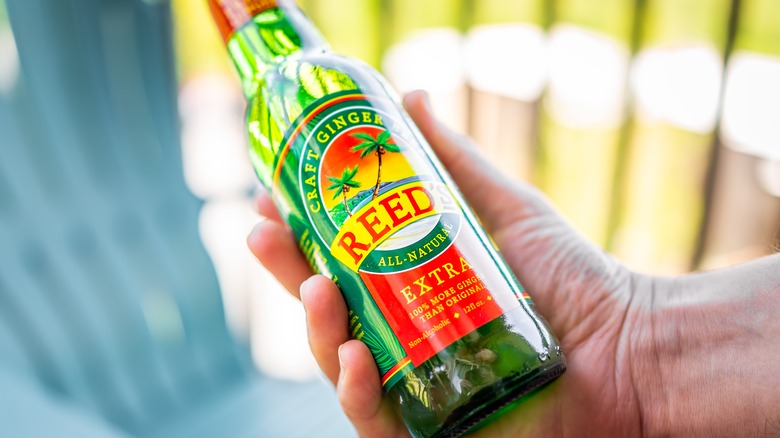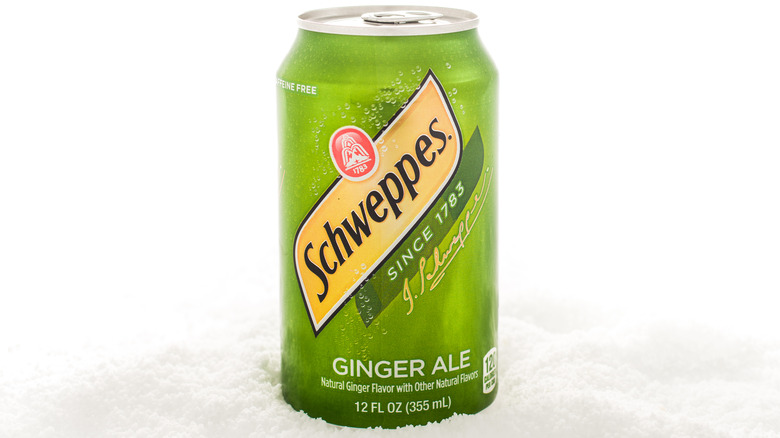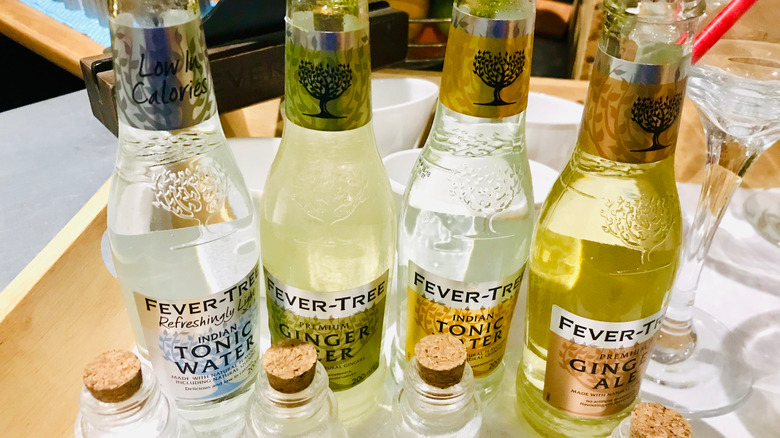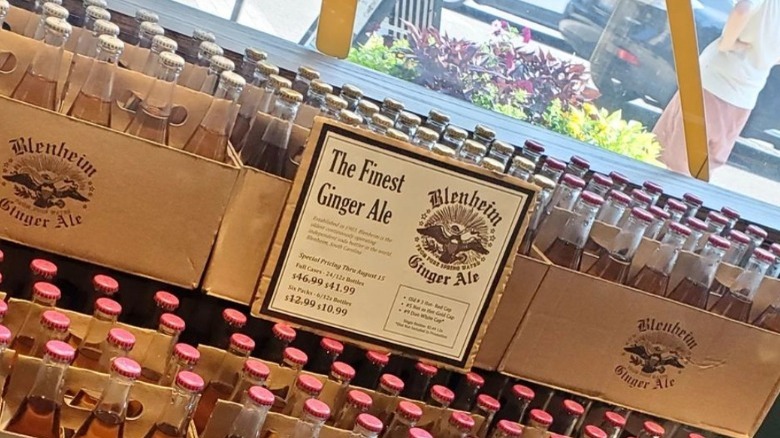12 Popular Ginger Ale Brands Ranked Worst To Best
The number of ginger ale brands on the market can be overwhelming. But things were not always this way. Developed by an Irish apothecary and surgeon Thomas Joseph Cantrell in the 1850s, ginger ale has come a long way since its start as a sugary, dark-colored concoction. Ranging from mild to throat-scorching, today the caffeine-free beverage combines a complex blend of ingredients that is simultaneously spicy, citrusy, and sweet.
Throughout the years, the carbonated beverage has been used to ease upset stomachs, soothe sore throats, and nurse pesky hangovers. And even if the health benefits of ginger ale may be questionable, there is little doubt that the fizzy soda is both delicious and refreshing. Plus, it makes an excellent addition to cocktails like Pimm's Cup and classic mocktails such as the Shirley Temple.
Ginger ale shouldn't be confused with ginger beer. While both beverages are non-alcoholic and ginger-flavored, ginger beer is brewed and fermented while ginger ale is essentially a carbonated soft drink. Not all ginger ales are created equal, however. Depending on the brand, ginger ales feature different carbonation, sweetness, and heat levels. With this in mind, here is a list of the most popular ginger ale brands out there ranked worst to best.
12. Thomas Kemper
While the Thomas Kemper Ginger Ale was only launched in 2001, but the brand started as a microbrewery back in the 1980s. It made its first non-alcoholic beverage — the Thomas Kemper Root Beer — for the Thomas Kemper Oktoberfest in 1990. In fact, the company's claim to fame is its entry in the "Guinness Book of Records" for crafting the world's biggest root beer float. According to the Puget Sound Business Journal, the float consisted of 2,100 gallons of root beer and 300 gallons of vanilla ice cream mixed in a 13-foot high tank.
What makes Thomas Kemper Ginger Ale stand out from the pack are its honey undertones and natural Jamaican ginger. It's not specified whether the soft drink actually contains real ginger, although the brand has mentioned that it uses real honey and more specifically pure Washington honey. The addition of high fructose corn syrup makes this ginger ale one of the sweeter options on the market. The recipe also uses caramel to give the beverage its amber hue.
11. Vernors
One of the oldest brands of ginger ale in the U.S., Vernors Ginger Ale is the brainchild of a Detroit pharmacist James Vernor who started selling the tangy drink at his store in 1866. The ginger ale was such a success that Vernor closed his pharmacy in 1896 to open a plant where he could focus solely on manufacturing the beverage (via Detroit Historical Society). Today, Vernor's is owned by Dr. Pepper Snapple Group, which also owns dozens of other soda brands including Sunkist Soda, Orangina, and perhaps most interestingly one of North America's most iconic ginger ale brands Canada Dry.
While Vernor's recipe has changed over the years, the beverage is still one of the most popular ginger ale brands on the market thanks to its full-bodied flavor and the feeling of nostalgia that it conjures. "Growing up, we always had Vernor's in the house, and a couple of times, when I was younger, I went down to the Vernors factory on Woodward Avenue with my grandparents. I prefer to drink Vernor's over everything else — warm, cold, with ice cream — it doesn't matter," Detroit resident Mike Wisniewski told Detroit Free Press.
10. GuS
GuS, or Grown-up Soda, is a complex and very dry beverage with a lingering ginger flavor that doesn't hit you until you've had a few sips. It also exhibits hints of fruit and citrus without being overly sweet (via Ginger Ale Authority). Made with ginger root extract and cane sugar, the pasteurized beverage is on the healthier side (it's still a soda) with Non-GMO ingredients and no preservatives. It's also forgiving on the hips with just 90 calories per bottle.
GuS was launched in 2003 by a husband and wife team, Steve Hersh and Jeannette Luoh, from their New York City apartment. "We loved soda but we felt like there was something missing in the market. Something natural, refreshing but not too sweet so we set out to make our own. In our kitchen, we blended juices, natural extracts like ginger ... and a little bit of cane sugar to come up with a line of less sweet sparkling beverages," Hersh said in a YouTube video.
9. Seagram's
Seagram's has a chequered history. Originally a distiller, the Canadian company had to pay $1.5 million in fines to the U.S. government when it first set up shop in the country in the 1930s. The fine was a settlement of the excise taxes on the liquor the company illegally exported to the U.S. during Prohibition. Fast-forward around 70 years and Seagram's line of mixers — by this stage the company had fingers in many pies — was acquired by The Coca-Cola Company in 2002.
With Seagram's Ginger Ale billing itself as "naturally flavored," it's easy to presume that it contains real ginger. A further inspection of the soda's ingredients reveals that it contains "ginger extract with other natural flavors." Whatever that means, the beverage has a crispy, mild ginger taste that is similar to Canada Dry. Plus, it features distinct citrusy notes, making it an ideal mixer for alcoholic beverages and a great addition to cocktails. Seagram's Ginger Ale contains genetically-engineered ingredients.
8. Q Ginger Ale
Infused with "agave, ginger, and a delicate blend of spices," Q Ginger Ale is tangy without being overbearing. The agave, in particular, makes a great sweetening substitute for the high fructose corn syrup typically found in ginger ale. Some other unique — and perhaps somewhat unexpected — ingredients that make up this crisp beverage include rose oil, coriander, cardamom, and orange peel.
Q Mixers was launched in 2007 with a mission to craft mixers that perfectly complement alcoholic beverages. The brand's founder Jordan Silbert said, "I started Q Mixers after a warm summer night in my backyard with great friends and good gin. A few sips in, my teeth felt sticky, the bubbles were gone, and the taste of my gin was lost in cloying sweetness. Picking up the tonic water I saw why –- a big plastic bottle already flat, loaded with high fructose corn syrup. I set out to make superior mixers. Ones that would make my favorite drinks even better."
7. Bruce Cost
Bruce Cost Ginger Ale is "made with 100% real ginger," although the brand's website doesn't disclose exactly how much ginger is in each of the beverage's bottles. Sweeter and closer in taste to soft drinks such as 7UP, Bruce Cost Ginger Ale is an easy drink without the huge ginger kick of some other similar beverages. And since the soda is unfiltered, ginger ale aficionados can expect to find ginger particles at the bottom of each bottle. Bruce Cost Ginger Ale is also made from pure cane sugar, considered by many to be a superior choice to high fructose corn syrup.
Like many other ginger ale brands, Bruce Cost offers the tangy root concoction in multiple flavors in addition to its original ginger ale. These include tangy passionfruit with turmeric, antioxidant-rich pomegranate with hibiscus, earthy jasmine tea, and citrusy blood orange with Meyer lemon. For those looking after their waistline, there is also the 66-calories ginger ale.
6. Blue Sky
The Blue Sky story begins in 1971 with an emphasis on natural flavors and two guys delivering beverages around Santa Fe, New Mexico in a van. Fast-forward to today and the brand remains as committed as ever to natural, Non-GMO ingredients — and
Blue Sky Ginger Ale is no exception. This said Blue Sky's ownership changed in 2015 when the Coca-Cola Company acquired the brand along with Hansen's Natural (both brands were previously owned by Monster Beverage). The soda also now comes with a new tagline, "Rooted in Real" (via The Coca-Cola Company).
Sweetened with cane sugar, Blue Sky's version of ginger ale has a somewhat different flavor to similar beverages sweetened with high fructose corn syrup. And while the bubbly soda packs a zesty punch that prickles the tongue and the back of the throat — some have compared it to ginger beer — the drink remains crisp, refreshing, and easy to drink (via Ginger Ale Authority). All in all, it's easy to see why Blue Sky is one of today's most popular ginger beer brands.
5. Reed's
Dating back to 1987, Reed's is a retailer of gingery candies and beverages. And while the company is better known for its ginger beer, it turns out that Reed's Ginger Ale is nothing to sneeze at either. Twangy with a fair kick, the beverage is closer in taste to ginger beer than most other ginger ales.
Crafted from a Jamaica-inspired recipe, Reed's Ginger Ale is made with real ginger, honey, fruit juices, and spices. Unlike many of its counterparts that are merely ginger-flavored, according to numerous retail websites, Reed's highly carbonated take on the soda contains 17 grams of pressed organic Non-GMO ginger root in every bottle.
Reed's ginger ale comes in three spice levels. Original with the lightest spice level, extra with a medium spice level (two times the ginger root of the original), and strongest with the most intense spice level (three times the ginger root of the original). The brand also has grape and cherry ginger ale flavors.
4. Schweppes
Founded in 1783, Schweppes is one of Coca-Cola's oldest and most well-known brands. Interestingly, the company's founder Jacob Schweppe patented his own process of producing carbonated beverages. His inventiveness was so revolutionary that customers soon began calling Schweppes drinks "lightning in a bottle" due to the fact that they retained carbonation so well. In 1851, the brand was the official drink of the Great Exhibition at the Crystal Palace in London. The fountain, which was the centerpiece of the event, still appears on the Schweppes logo (via Schweppes).
While the brand initially focused on tonic water, it launched its first ginger ale in 1870. It was an instant hit. Sweet, highly carbonated, and characterized by mild ginger tones, Schweppes Ginger Ale remains one of the most popular fizzy drinks on the market. Plus, the beverage comes in a variety of flavors including Dark Ginger Ale (Schweppes ginger ale is usually lightly-colored), Raspberry Ginger Ale, Dry Grape Ginger Ale, and Black Cherry Ginger Ale. Some of these flavors also come in diet versions.
3. Fever Tree
Launched in 2003, Fever Tree Ginger Ale offers a more boutique take on ginger ale than that offered by bigger brands such as Canada Dry and Schweppes. Lightly tart, the beverage delivers in both the carbonation and ginger flavor departments. Perfectly balanced between sweet and dry, it comes with a spicy bite without being overwhelming. The ginger ale's full-bodied taste is the result of a blend of "three of the world's finest gingers." These include ginger roots from Cochin in India, the Ivory Coast, and Nigeria.
Considered by many to be a gourmet take on the ubiquitous beverage, Fever Tree Ginger Ale is a favorite with mixologists. This is apt because the founder of Fever Tree, Charles Rolls, started the company with mixers in mind. Rolls, who owned a gin company at the time, realized that the spirit's quality could be affected by a subpar mixer. Not surprisingly, Fever Tree's first soda was tonic water. Ginger ale followed shortly after (via Fever Tree).
2. Blenheim Ginger Ale
Produced in South Carolina, Blenheim Ginger Ale has a fascinating history. According to the Blenheim website, the brand's story started in the late 1800s when Dr. C. R. May advised his patients with stomach problems to drink water from the local mineral springs. The same doctor later added Jamaican Ginger to the water to camouflage its iron taste and in 1903 co-founded the Blenheim Bottling Company.
Blenheim's ginger ale comes in three different varieties. The original #5 Not as Hot Blenheim Ginger Ale offers a well-crafted balance of citrus, sweetness, and spice. While for most ginger ale enthusiasts, this blend delivers sufficient bite, those wishing to kick their ginger ale experience up a notch can opt for Old #3 Hot Blenheim Ginger Ale. This extra fiery version of the soda "goes down as smoothly as a firecracker exploding in your throat." (via Blenheim). Last but not least, there is also the #9 Diet Ginger Ale with low-calorie sweeteners.
1. Canada Dry
Possibly one of the most popular ginger ale brands in the U.S., Canada Dry has been on the market since 1904. The story goes that the fizzy beverage was popular during Prohibition since its taste made it ideal for masking the unpleasant taste of bootlegged liquors. (via Canada Dry).
Billing itself as the "champagne of soda," Canada Dry Ginger Ale is fizzy, crisp, and refreshing, with just the right hint of ginger (definitely don't expect a huge kick from the original version). Plus, it has citrus overtones and is less sweet than many of the other ginger ales out there, hence its name — Canada Dry. Those looking for a ginger kick can try the brand's Bold Ginger Ale. Canada Dry also offers Cranberry Ginger Ale, Ginger Ale and Orange, Green Tea and Ginger Ale, and Ginger Ale and Lemonade.
Considering its popularity and overwhelming presence on the supermarket shelves, some may find it surprising that Canada Dry has been sued for its lack of real ginger. In 2018, Julie Fletcher filed a class action against Canada Dry after she couldn't find ginger on the soda's list of ingredients. The lawsuit resulted in an $11.2 million settlement and forced the company to drop the line "Made from Real Ginger" from its products (via Market Watch).
